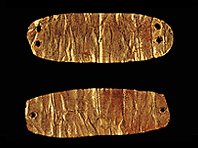 
The desire to adorn the body induced man, already from the Upper Palaeolithic, to make jewellery from bones, animal teeth and sea-shells. During the Neolithic Period the widespread use of jewellery of various forms, which did not simply constitute elements of personal adornment but also carried social symbolism, has been observed. They were made in the Pre-Pottery Neolithic from stone, sea-shells, animal bones and more rarely from clay, while during the Late Neolithic II and Final Neolithic silver and gold were used, to a small degree though. The choice of materials resistant in time, mainly stone, shows the importance attributed by Neolithic man to his personal symbols, which accompanied him in every day life but also in life after death. |

In the early phases of the Neolithic, jewellery was made by individuals with special skills in the working of the above mentioned materials, in their free time. From the Late Neolithic, when specific types (beads, buttons, bracelets, ring idol pendants) began to be reproduced, it seems that jewellery making was a scheduled activity. Dimini in Thessaly constituted during this period a centre for making jewellery from Spondylus sea-shell. |

Sea-shells, which were used as jewellery in their natural form and with no special working, included cockle, limpet, cone shell and sea-shells of the Dentalium and Cypraea types. Sea-shell (Spondylus gaederopus Linne) was a valuable sea-shell during the Late Neolithic, of which bracelets, pendants (zoomorphic pendants from Kitsos Cave), buttons etc., were made, similar to those that were exchanged in the Balkans and Central Europe. From the bone of sheep and goats, the teeth of dogs and wild animals, pendants, beads, needles etc. were made. Among the bone pendants, anthropomorphic ones stand out from Kitsos Cave in Attica and Saliagos in the Cyclades (Late Neolithic I). Slate, marble, jasper, steatite and basalt were the materials favoured for the creation of anthropomorphic and zoomorphic pendants, phallus-shaped or button-shaped ("earrings") objects. |

Earrings, necklaces, ring idol figurine-pendants of silver and gold (Alepotrypa-Diros) and gold strips (Aravissos-Pella, Zas Cave-Naxos) hold a special place in jewellery-making of the Late and particularly the Final Neolithic. |